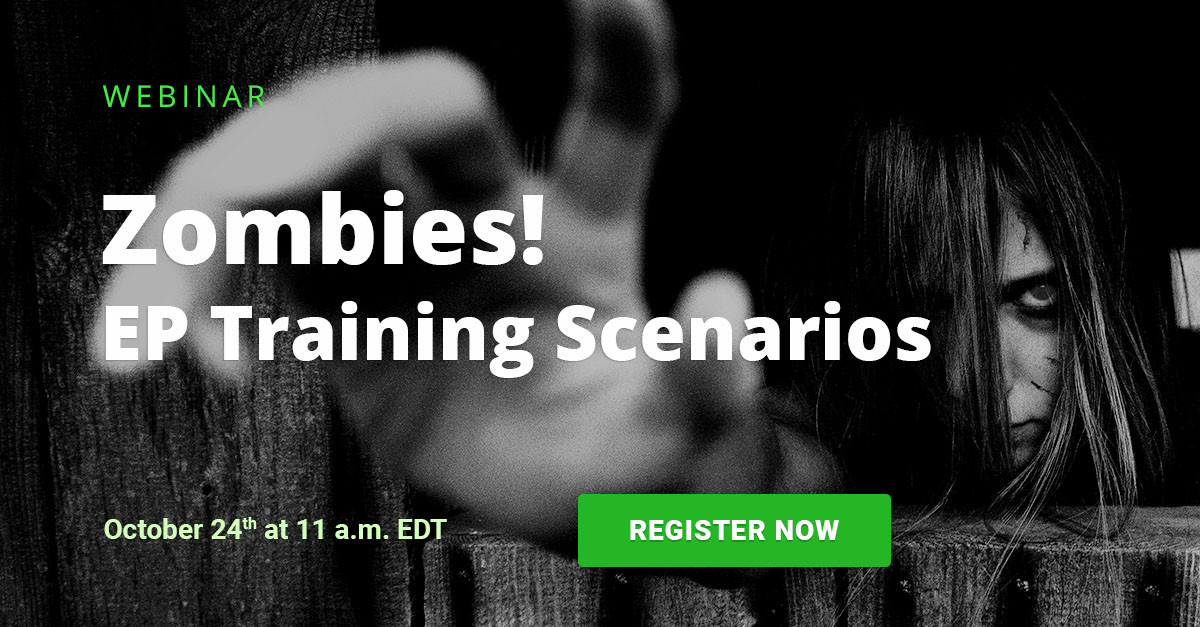No More Boring Training! Create Engaging Exercises With Zombies
How many employees have you encountered who were excited for emergency preparedness training? Not many, right?
It is understandably difficult to develop emergency preparedness training programs. For starters, you need to ensure that the majority of staff will be onsite or available for emergency preparedness training – that means avoiding the days before, during and after major holidays as well as mission-critical days for your operations (for example, the launch of a new product or office).
But just because you have people present for emergency preparedness training doesn't mean you have their full attention.
Hurdles To Engagement
Emergency preparedness may be the top priority for you, since it's one of your responsibilities, but it's typically not a priority for the average employee.
Managers have reported some of the common issues that make it difficult for employees to engage with emergency preparedness training. They include:
- Lack of interest or inability to see how these issues relate to them
- Material is uninteresting or doesn’t offer pragmatic tips they can use
- Material is too advanced and not accessible to the average employee
As an emergency preparedness professional, you know that this training applies to everyone – whether the risk is naturally occurring (like wildfires or hurricanes) or man-made (like terrorism and cyber threats). And employees need emergency preparedness training to ensure their safety and the resiliency of the organization.
Engagement Solutions
Once you have them in the room (or logged in), you have to keep their attention and “flip the script.” In a recent AlertFind webinar, “Get Ready for the Zombie Apocalypse,” business continuity expert Bob Clark said organizations who get creative with training will make it memorable for employees.
“For our zombie exercises, you can make it a simple live event by simply handing out index cards that assign people to the different groups or to the zombies,” he said. “Or you can make it very involved and hire actors, do fake blood and makeup, have video clips running in the background. The sky’s the limit, really.”
Using themes like zombies allow employees to engage with the topic and learn key emergency preparedness principles. Even the Centers for Disease Control and Prevention (CDC) has its own zombie preparedness page. And while it may have been created with a wink, it achieved the goal of drawing visitors into the page, learning from it and possibly exploring other CDC pages.
By creating emergency preparedness training material that draws on pop culture, you can play to your employees' interests. Think of it as “infotainment” that offers tactical advice on what to do in specific situations.
For your zombie training, get employees out of their chairs and split into groups of zombies and survivors. As they run through the scenario, they'll expose certain risks just by going through the motions. Additionally, employees will be more likely to ask questions when they have access to an expert trainer.
By training the staff regularly in a way that is truly memorable, they will gain valuable knowledge and build their skills. Additionally, the feedback and results can be used as a repository of information for the organization.
“What zombies can or can’t do is all down to someone’s imagination,” Clark said. “That, in turn, stimulates the interest of all the people who will go to the theater and watch it on the television. So it’s something they’re already interested in. And if you can introduce it into their work lives by means of a exercise that ultimately could save their lives, then you’re going to get their immediate attention because of the subject matter.”
For more information on how to implement emergency preparedness training programs, watch AlertFind's recent webinar, “Zombie Apocalypse! Bring Your Training Exercises To Life,” with business continuity expert Bob Clark.

You are well on your way toward protecting your staff and organization.
Take the next step toward protecting your organization by learning more about emergency notification systems and the vital role they play in your emergency preparedness plan.
